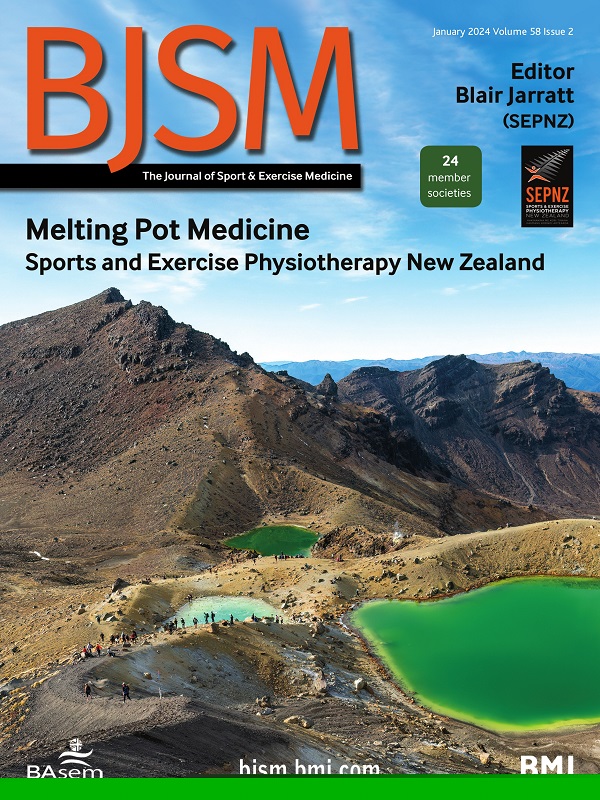‘First, do no harm’: conducting research on interpersonal violence in sport
IF 11.6
1区 医学
Q1 SPORT SCIENCES
引用次数: 0
Abstract
It was Hippocrates who stated ‘First, do no harm’, and we believe the sentiment of this medical principle is one that every researcher should embody when conducting research on interpersonal violence (IV) in sport. Conducting such research presents unique considerations for researchers, particularly in relation to supporting participant and researcher well-being. Similarly, approaching this sensitive topic with clear definitions of IV in sport and an understanding of trauma- and violence-informed care (TVIC) is paramount to the protection and care of everyone involved in the research. The landscape for researching IV in sport that has rapidly emerged to investigate its determinants from various lenses including ethical, sociological, psychological, criminological and organisational.1 2 The siloed nature of research on IV in sport also has led to inconsistency in terminology, hindering effective communication and collaboration within and outside the field. The terms used to describe and study IV in sport have a profound impact on how the problem is communicated and understood. The use of diverging definitions creates challenges for determining what is within or outside the scope of research, limits our ability to meaningfully compare prevalences and experiences reported across projects, and impacts methodological considerations such as the effective recruitment of participants. Currently, terms such as maltreatment, non-accidental violence, harm, harassment, abuse and IV are used interchangeably, and clarification on the use of terminologies is essential. This paper aligns with the latest International Olympic Committee (IOC) Consensus Statement1 and the WHO’s typology of violence3 and focuses on ‘ interpersonal violence’, which differs from self-directed and collective violence (box 1). Box 1 ### Glossary with operationalised definitions of interpersonal violence in sport首先,不要伤害":开展体育运动中的人际暴力研究
希波克拉底曾说过 "首先,不要伤害他人",我们相信,在对体育运动中的人际暴 力(IV)进行研究时,每位研究人员都应恪守这一医学原则。开展此类研究对研究人员提出了独特的考量,特别是在支持参与者和研究人员的福祉方面。同样,在研究这一敏感话题时,明确体育运动中人际暴力的定义并了解创伤和暴力知情护理 (TVIC),对于保护和护理参与研究的每个人至关重要。1 2 对体育运动中暴力行为的研究各自为政,也导致了术语的不一致,阻碍了该领域内外的 有效交流与合作。用于描述和研究体育运动中的 IV 的术语对如何交流和理解这一问题有着深远的影响。使用不同的定义会给确定哪些属于研究范围之内,哪些不属于研究范围之 外带来挑战,限制我们对各项目所报告的普遍性和经历进行有意义的比较,并影响到诸如有 效招募参与者等方法论方面的考虑。目前,虐待、非意外暴力、伤害、骚扰、凌辱和 IV 等术语被交替使用,因此澄清术语的使用至关重要。本文与最新的国际奥林匹克委员会(IOC)共识声明1 和世界卫生组织的暴力类型学3 保持一致,重点关注 "人际暴力",它不同于自发暴力和集体暴力(方框 1)。方框 1 ### 体育运动中的人际暴力操作化定义术语表
本文章由计算机程序翻译,如有差异,请以英文原文为准。
求助全文
约1分钟内获得全文
求助全文
来源期刊
CiteScore
27.10
自引率
4.90%
发文量
217
审稿时长
3-8 weeks
期刊介绍:
The British Journal of Sports Medicine (BJSM) is a dynamic platform that presents groundbreaking research, thought-provoking reviews, and meaningful discussions on sport and exercise medicine. Our focus encompasses various clinically-relevant aspects such as physiotherapy, physical therapy, and rehabilitation. With an aim to foster innovation, education, and knowledge translation, we strive to bridge the gap between research and practical implementation in the field. Our multi-media approach, including web, print, video, and audio resources, along with our active presence on social media, connects a global community of healthcare professionals dedicated to treating active individuals.

 求助内容:
求助内容: 应助结果提醒方式:
应助结果提醒方式:


